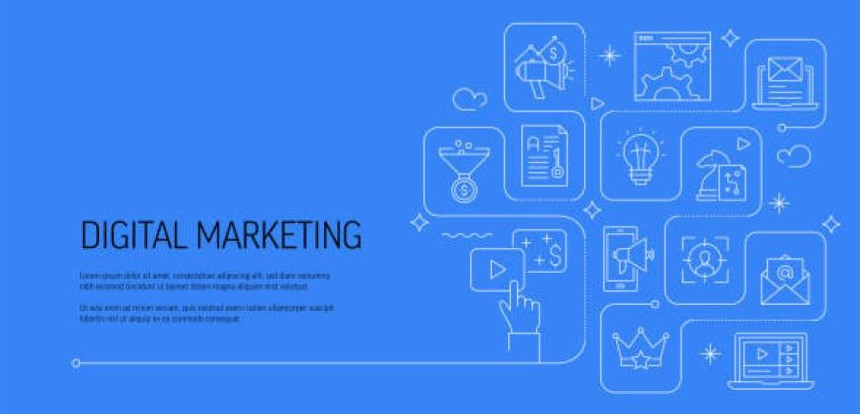Growing a business requires far more than just gaining followers or increasing traffic numbers, it often takes some creative thinking and strategic planning. A practical digital marketing approach can make all the difference in reaching and engaging potential customers.
These guidelines will explore five essential digital marketing tactics to help small businesses grow and succeed in today’s rapidly evolving online world. So read on for tips on leveraging these tactics to improve your overall digital presence and drive profits!
Develop A Comprehensive Digital Marketing Strategy.
Developing an effective digital marketing strategy is critical to success for small business owners. It requires understanding the target market, assessing the current marketing landscape, and implementing creative tactics tailored to help your business reach its goals. Here are a few key elements to consider when creating a comprehensive digital marketing strategy for business:
• Identify Your Target Audience
Understanding who you’re trying to reach is one of the essential aspects of any digital marketing plan. Consider who your ideal customer is and how they might interact with your online presence. Analyze their interests, behavior, preferences, and needs to create more effective campaigns that resonate with them.
• Research Your Market
Knowing what markets are available to you and which ones may be most lucrative can be beneficial when creating your digital marketing strategy. Conduct market research to understand which channels your customers use most often and trends in online behavior related to buying decisions and overall engagement levels.
• Determine Your Objectives & Goals
Before implementing digital marketing tactics, setting objectives and determining what you hope to achieve with each campaign is important. Whether it’s increasing website traffic or gaining more followers on social media platforms, having clear goals will help you measure the success of your efforts over time.
• Develop Creative Content Strategies
Content plays a vital role in any digital marketing plan – from blog posts, and videos to podcasts and infographics – each piece should work together to help promote your brand or services. Create attractive, informative, relevant, and engaging content for your target audience to drive conversions or generate leads.
• Utilize Digital Advertising Platforms
Digital advertising can be a powerful tool for getting the word out about your products or services while connecting with potential customers on a deeper level. Research different platforms, such as Google Ads or Facebook Ads, to determine which could benefit your business most effectively.

• Monitor & Adjust Your Approach
A successful digital marketing strategy isn’t set in stone; it should be continually monitored and adjusted based on data gathered throughout its implementation. Track performance metrics across all channels so you can make changes if they don’t produce the desired results.
By following these steps when creating a comprehensive digital marketing strategy for small businesses, owners can better understand their audiences’ needs while effectively reaching those consumers using tailored tactics explicitly designed for them — ultimately boosting profits and growing their businesses!

Increase Website Traffic With SEO And Paid Ads
SEO and paid ads are two effective digital marketing tactics for small business owners to increase website traffic. With the right strategies and implementation, these tactics can help businesses reach their target people and drive more profits.
Key Benefits of SEO & Paid Ads:
- Reach potential customers when they’re actively searching for products/services.
- Increase visibility on search engine results pages.
- Establish brand awareness.
- Generate more qualified leads.
- Improve return on investment (ROI)
Online Marketing Strategies to Implement SEO & Paid Ads:
1. Conduct Comprehensive Keyword Research
The key to SEO or paid ads success is identifying the most relevant terms your potential customers use while searching online. It will allow you to craft content around those keywords, thus improving your organic rankings and boosting website traffic.
2. Create Engaging Content
You should tailor content toward the needs of your target audience to capture their attention and drive engagement. Create informative, helpful, and engaging content so readers will stick around for extended periods.
3. Optimize for Mobile Users
You must optimize your website for mobile users since most web visits now come from mobile devices. Ensuring a smooth user experience across all platforms will boost website traffic and improve user engagement metrics like bounce rate and time spent on the site, which are tied directly to SEO rankings.
4. Leverage Social Media Platforms
Social media offers an excellent way for businesses to establish relationships with potential customers, build a community following, and stay top of mind with prospects. Adopting an integrated approach across multiple platforms allows companies to widen their online reach and gain valuable insights into customer preferences and behavior.
5. Monitor Performance and reevaluate Strategies
It ensures maximum ROI from your digital marketing efforts; keeping track of performance metrics such as website clicks, conversions, average session duration, etc., and adjusting strategies accordingly when needed to maximize results over time is essential.
Convert Website Visitors Into Customers With Effective Lead-Capture Forms.
Digital marketing is essential for small businesses to increase their online presence and reach more customers. One of the most successful tactics you can use to generate leads and convert web visitors into paying customers is implementing effective lead-capture forms on your website. Here are a few tips and best practices for using lead-capture forms to make the most of your digital marketing efforts:

• Understand Your Target Audience
Knowing who your audience is and what they are will help you craft an effective lead-capture form that speaks directly to them. Consider their needs, interests, problems, and goals when designing a layout that will capture the information you need to begin building relationships with potential customers.
• Keep it Simple
When creating a lead-capture form, it’s essential to keep it simple and easy to fill out. Ask only a few questions or require too much information, which may deter potential customers from completing the form.
• Use Strategic Placement
Ensure that your lead-capture forms are strategically placed throughout your website so potential customers can easily find them – but not so overwhelming that it turns them off from completing the form in the first place! Try placing them prominently at the top of the page or near popular products or blog posts.
• Utilize Automation
Once your lead-capture forms are up and running, use automated email messages or other follow-up methods to nurture leads until they become paying customers. It will help ensure that potential customer is noticed!
By using effective lead-capture forms on your website, you can take full advantage of digital marketing ideas for small businesses and convert more website visitors into paying customers. With these tips, you’ll be well on your way toward creating an effective online presence that drives growth!
Check out 11 Essential Digital Marketing Tips here.
Nurture Leads With Automated Email Marketing Campaigns

Key Benefits:
- Increase customer engagement and loyalty.
- Drive sales through targeted email content.
- Automate customer communication to save time and resources.
- Re-engage inactive leads with automated email campaigns.
- Generate insights into customer behavior with advanced analytics tools.
Email marketing is a vital tool for small businesses. It can help you build customer relationships, generate leads, and drive sales. The key to success is personalized, automated email campaigns tailored to the individual’s interests and needs. By creating an effective email marketing strategy, you can nurture leads, increase customer engagement, and ultimately boost your revenue.
Step 1 – Segment Your Audience
The first step in creating an effective email marketing campaign is to segment your audience according to their interests. Behaviorism will allow you to make more targeted emails relevant to each individual’s preferences. For example, if you sell clothing products, you can segment your audience into men’s or women’s fashion categories based on their buying history or browsing behavior. Doing so will ensure that customers receive the right messages at the right time.
Step 2 – Develop Engaging Content
Once you have segmented your audience, it’s time to develop engaging content that resonates with them. Ensure your emails are relevant, informative, and valuable. It will encourage readers to click through and purchase from your website or view additional content on social media platforms like Facebook or Instagram. Also, consider including visuals such as videos or images, as these can make emails more memorable and effective at driving conversions.
Step 3 – Set Up Automated Trigger Emails
Trigger emails are automated messages sent when someone completes a specific action or shows a particular behavior on your website or social media accounts. For example, if a customer purchases from your online store but does not leave a review afterward – you can send them an email prompting them to do so. This automated response helps keep customers engaged, increasing the chance of making future purchases.
Step 4 – Track Your Performance
Finally, try our campaigns’ performance by analyzing metrics like open rates, click-through rates (CTRs), conversion rates, etc. You can also use the A/B testing technique to optimize performance by testing different versions of the same email against each other to determine which version works best for each particular target group. Tracking performance will enable you to improve your campaigns’ effectiveness over time continuously!
Analyze Results And Optimize Your Efforts For Continued Growth
Finally, only once campaigns have been running successfully, lately, it must be analyzing results to maximize efforts made in the future—this is done by tracking key performance indicators (KPIs) such as Key Points:

- Utilize analytics tools to monitor the performance of digital campaigns and track progress.
- Keep up with trends and changes in the digital marketing landscape.
- Adjust your tactics based on the data collected from previous campaigns.
- Invest in experimenting with different platforms, channels, and strategies.
- Leverage A/B testing to identify the most effective digital marketing strategies.
Analyzing and optimizing your digital marketing efforts is essential for small businesses looking to increase their online presence and profitability. By leveraging analytics tools, you can monitor the performance of your campaigns, track your progress over time, and adjust your tactics accordingly. It will help ensure you get the highest return on investment from the effort you put into your marketing strategy.
Additionally, it’s important to keep up with trends and changes in the digital marketing landscape so that you can adjust as necessary. Investing in experimentation with different platforms, channels, and strategies is also beneficial in finding what works best for you—and don’t forget about A/B testing!
By comparing two versions of a campaign or ad against each other, you can identify which one performs better and focus more resources on it for optimal results. Through these approaches and staying consistent with implementing them, you can optimize your digital marketing efforts for continued growth.
Conclusion
By now, we’ve seen how investing in a robust digital marketing approach for your small business can be essential to reaching and engaging with potential customers. Determining the right strategy for your business is an ongoing process that requires goal setting, creative thinking, and strategic planning. While there will always be new trends and developments in the digital marketing world, the five digital marketing tactics covered here provide key foundations that any business owner can use as they embark on their journey to success.
So now it’s up to you to determine which strategies work best for you. And with the right skills, knowledge, and drive, you, too, could create an impactful and profitable growth strategy for your small business. Let’s explore what ensures your brand stands out from the competition and reaches its full potential!
Keetria is an entrepreneur, wellness advocate, and brand strategy coach for creatives & entrepreneurs with 16 years of public relations expertise working with some of the world’s leading brands, startups, media personalities, and entertainers. If you want to work together, don’t hesitate to reach out!








